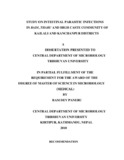Please use this identifier to cite or link to this item:
https://elibrary.tucl.edu.np/handle/123456789/609| Title: | Study on intestinal Parasitic Infections in badi,Tharu and Highcastecommunity of Kailali and Kanchanpur Districts |
| Authors: | Paneru, Bam Dev |
| Keywords: | intestinal parasites;Kanchanpur District;intestinal parasites |
| Issue Date: | 2010 |
| Publisher: | Central Department of Microbiology |
| Institute Name: | Central Department of Microbiology |
| Level: | Masters |
| Abstract: | Present study was carried out inBadi, Tharuand high castecommunity to determine theprevalence of intestinal parasitic infection. High castepeople wereselected from MalakhetiVDC 1 and 3, Kailali.Badipeople were selected from Malakheti VDCward no.1 and 3,Kailali and from Raikwar BichawaVDC wardno3, Kanchanpur.Tharuwere selected fromKrishnapur VDC ward no.3 Kanchanpur. This study also specifies the correlation betweenparasitic infection and sanitary facilities, source of drinking water, public health awareness,occupation, socio-economic status and others among these ethnic groups. The study wasconducted from September 2009 to May 2010. Altogether 378 samples were collected (123fromBadi,128 fromTharuand 127 from high castecommunity). The samples were formalinfixed and brought to Kathmandu. The laboratory processing ofsample was carried out at ShiGan health Foundation, Maharajgunj, Chakrapath, Kathmandu. The sampleswere examinedusing direct wet mount using iodine solution after the samples had been concentrated byformalin-ether sedimentation technique. The overall prevalence of intestinal parasites wasfound to be 35.19%, out of which 24.06% had multiple parasitism and 75.94% hadmonoparasitism. Males were marginally more infected (36.00%) than females (34.48%)(p>0.05). Prevalence of intestinal parasitic infections wassame inBadi(47.97%) andTharu(47.66%) community, but lower in high caste community (10.24%). Males had higherprevalence than females inTharu(male; 50.79%, female; 44.62%) and inhigh caste(male;11.32%, female; 9.72%) community, whereas females had higher prevalence in Badicommunity (male; 43.86%, females; 50.52%). Prevalence of multiple parasitism was19.51%, 4.69% and 1.57% inBadi,Tharuand high castecommunity respectively. Amongpositive stool samples, hookwormwas most common helminthes (46.62%) andGiardiawasmost common protozoa (36.09%). Total of 6 parasites; hookworm,Giardia,E. histolytica,E.coli,H. nanaandB. hominiswere detected. Hookworm occurred in highest prevalence inTharu(34.38%) community and all other parasites occurred in highest prevalence inBadicommunity (Giardia:28.46%,E. histolytica: 24.06%,E. coli: 6.50%,H. nana: 4.88% andB.hominis: 2.43%). Children (0-15 years) were marginally more infected (36.08%) than adults(34.24%) (p> 0.05). Among children, prevalenceof intestinal parasitic infectionwas highestin Badi(56.72%), followed by Tharu (40.94%) and high caste (10.61%) community. 6 Prevalenceof intestinal parasitic infectionwas found to be same among people of agriculture(42.00%) and other (42.74%) occupation but lower among people with study occupation(18.01%).The rate of parasitic infection was very high among those suffering from recentgastrointestinal disease (87.25%) than among non sufferers (1.31%)(p<0.01). The rate ofintestinal parasitic infection was higher among those who had taken anti-parasitic drugswithin past 6 month(70.59%) than among those not having drugs (31.69%) (p<0.01). Higherprevalence of intestinal parasitosis was observed among those who did not wash their hand(81.11%) than among those who washed their hand (20.83%) before eating (p<0.01).Prevalence of intestinal parasitosis was found to be higher among those who did not cut theirnail (82.02%) than among those who cut their nail (20.76%) regularly (P<0.01). People whodrunk non treated water weresuffered more (48.62%) than who drink treated water (8.00%)(p<0.01). Higher prevalence of intestinal infection was found among those not having toilet(57.87%) than among those having toilet at home (10.50%) (p<0.01). Hence prevalence ofintestinal parasitic infection was studied along with correlation of different parameters. Key words: Badi, Tharu, high caste, intestinal parasites, Kailali District, KanchanpurDistrict, Malakheti VDC, Krishnapur VDC, Raikwar VDC. 7 |
| URI: | http://elibrary.tucl.edu.np/handle/123456789/609 |
| Appears in Collections: | Microbiology |
Files in This Item:
| File | Description | Size | Format | |
|---|---|---|---|---|
| THESIS.pdf | 283.81 kB | Adobe PDF |  View/Open |
Items in DSpace are protected by copyright, with all rights reserved, unless otherwise indicated.
